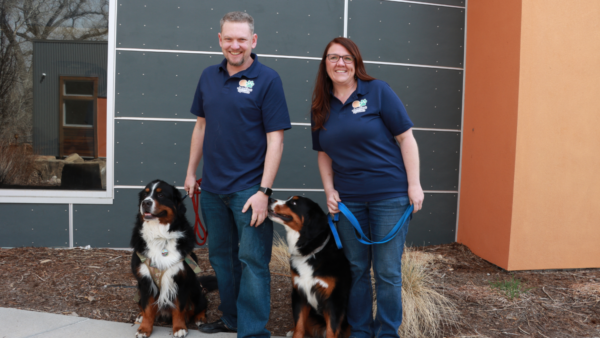A service dog is a working animal which can be trained to help people with visual impairments, hearing impairments, autism, PTSD, diabetes, seizures, allergies and mobility issues. A service dog can be very useful to its owner/guardian, but it’s not always affordable for people to get a dog which has already been trained. A trained service dog can cost you $15,000—$50,000.
As a result, many people opt to go the DIY route; they get a dog which is still a puppy and train it to be a service dog. As long as the dog has the right temperament, it can get service dog training.
How to Choose the Right Dog
When you’re choosing a dog to be your service dog, there are certain characteristics you might want to look for.
- Temperament: It’s important for the dog to be calm with you, with other people and with other dogs. If the dog is too aggressive, that’s going to interfere with its service dog duties.
- Concentration: The dog should not get easily distracted. A service dog is going to have to perform tasks for you, so it should be able to focus on them. A dog that is spayed/neutered would be best; this will keep it from getting distracted by other dogs.
- Age: You can start teaching the dog the basics when it is 8 weeks old and then start with the more specialized tasks once the dog is six months old. Very old dogs may not be able to learn how to be service dogs, especially if they have diabetes or arthritis.
Keep in mind that certain dogs might be better for certain tasks. For example, if your mobility is impaired, then a large dog might be able to help you get around better than a small dog.
How to Train a Service Dog in the Basics
Every dog needs to learn the basics, but this is especially true of service dogs. Eventually, your dog should be able to do all the things listed on the Canine Good Citizen test.
Socializing Your Dog
A service dog needs to be comfortable around people and other dogs. You can start socializing puppies when they are 3 weeks old or older. Introduce the puppy to many people so that it gets used to being around them. At the same time, it should also be taught to be alone so that it doesn’t suffer from separation anxiety.
Potty Training Your Dog
It’s important to train your dog to “go” in an approved spot which is, ideally, outside the house. You can use dog crates, puppy pads and paper training to help train the dog. Taking the dog for frequent walks outside and praising it when it goes outside can also help in potty-training your dog.
Leash Training Your Dog
Your puppy will need to get used to being on a leash. Don’t be surprised if it resists doing this at first. The idea is to get the puppy used to the leash slowly. Try putting just the collar around its neck first. Then you can try putting on the leash and walking it indoors. Finally, you can start taking the puppy outdoors. If it gets distracted and starts pulling on the leash, don’t yank it. Just stand very still until the puppy stops pulling.
Giving Your Dog Specialized Training
After training service dogs in the basics, you’ll need to give them specialized training in the type of services you’d like them to provide. You can train your dog by using treats or giving it praise. You can also use a clicker; this involves clicking when the dog performs the action you want it to and following this up with a treat. Eventually, the dog will start responding to the clicker itself as a form of positive reinforcement.
The type of specialized training you give your service dog is going to vary, depending on your needs. Here are some of the specialized things that you can train your service dog to do:
- Hearing Service Dogs: These dogs can be trained to alert their owners when the phone rings, the doorbell rings or the fire alarm goes off.
- Guide Dogs: These dogs are generally used to help people who are blind or visually impaired. They can help their owners get around indoors as well as outdoors. They can help them cross roads, walk on pavements, find doors etc.
- Mobility Assistance Dogs: These dogs help people who have mobility issues. They can pull wheelchairs, bring over objects, open doors, turn on the lights etc.
- Diabetic Alert Dogs: These dogs can smell it when a person’s blood sugar level is going up or down and alert their owners when this happens.
- Seizure Response Dogs: For people who have epilepsy or are prone to seizures, service dogs can help by getting them away from situations that will lead into seizures. They can also bring the person’s medication or activate emergency alarms if the person has a seizure.
- PTSD Service Dogs: These dogs can help people with PTSD by calming them down in stressful situations. They can also bring their owners their medications or phones.
Take a look at this series of videos from Buzzfeed that follows a group of puppies as they train to become service dogs.
How Are Service Dogs Trained?
As mentioned above, you can get a dog that’s already trained, but this is likely to be expensive. The other option is to get a dog and train it yourself. This is something that has to start early and can take up to two years. However, it’s a great option if you want to save money and train the dog in doing very specific things. Praising and rewarding the dog goes a long way towards training it in doing the things you need it to do. Using a clicker also helps.
If necessary, you can also get a specialist to help you train your service dog. The best thing to do is check out their facility and make sure that it is run well. Getting a trainer who has a professional certification might also be a good idea. You can also look up the trainer on the better business bureau website to see if there are any complaints against them.
If you choose to train your own dog, it’s important to make sure that there’s a bond between you and the dog. This can be created by spending quality time with the dog—playing games and doing activities you both enjoy. You can also try tethering in which the dog is tethered to you with a 3-6 foot leash at all times. This leads into more interactions between you and the dog.
Keep in mind that building a relationship with a dog is like building a relationship with a human being. You have to interact frequently in a way that builds trust between you and the dog. You have to show the dog that you are there for it just as it’s going to be there for you.
We May Not Be Trainers…But We Know How to Find a Great One
At Justice Speaks, our mission is to advocate for service dog handlers, and we don’t train service dogs. We want you to know the best way to find and train your service dog because that’s the best way to have your needs met and get the best outcome possible. Reach out if you’d like information or advice on finding a great trainer near you!


